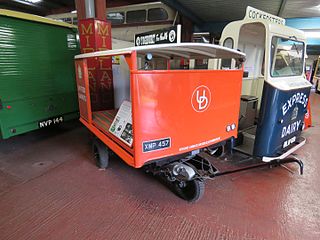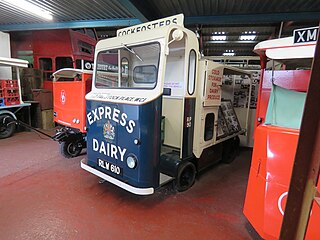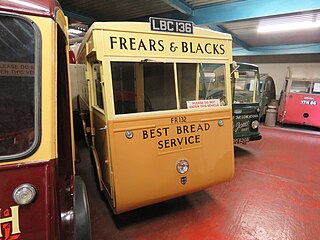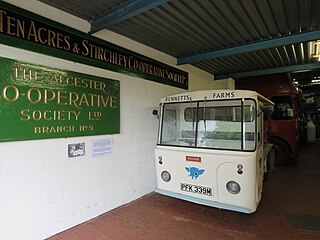
A milk float is a vehicle specifically designed for the delivery of fresh milk. Today, milk floats are usually battery electric vehicles (BEV), but they were formerly horse-drawn floats. They were once common in many European countries, particularly the United Kingdom, and were operated by local dairies. However, in recent years, as the number of supermarkets, small independent grocers and petrol stations, and convenience stores stocking fresh milk has increased, many people have switched from regular home delivery to obtaining fresh milk from these other sources.

A Neighborhood Electric Vehicle (NEV) is a U.S. category for battery electric vehicles that are usually built to have a top speed of 25 miles per hour (40 km/h), and have a maximum loaded weight of 3,000 lb (1,400 kg). Depending on the particular laws of the state, they are legally limited to roads with posted speed limits of 35 miles per hour (56 km/h) or less. NEVs fall under the United States Department of Transportation classification for low-speed vehicles. The non-electric version of the neighborhood electric vehicle is the motorized quadricycle.
Brush Traction was a manufacturer and maintainer of railway locomotives in Loughborough, England whose operations have now been merged into the Wabtec company's Doncaster UK operations.

The Commuter Cars Tango is a prototype ultra-narrow electric sports car designed and built by Commuter Cars, an electric car company based in Spokane, Washington.

An electric truck is a battery electric vehicle (BEV) designed to transport cargo, carry specialized payloads, or perform other utilitarian work.
The Buckeye Bullet is a series of four experimental electric cars created by students from Ohio State University as a joint project with Venturi. The cars were designed to break the land speed record on the Bonneville Speedway, a salt flat just outside Wendover, Utah, United States. The team first achieved its goal in October 2004, at 271.737 mph (437.318 km/h) for the one mile world record, repeatedly increasing the record until setting a mile world record of 307.666 mph (495.140 km/h), in 2009, and a one kilometer world record of 341.264 mph (549.211 km/h), in 2016.

Modec was an electric vehicle manufacturer in Coventry, in the United Kingdom, specialising in Commercial vehicles in the N2 category. It unveiled its first model in April 2006 and announced its intention to commence series production in March 2007, with the first production vehicles destined for Tesco. Following a long-term decline in sales, it entered administration in March 2011, with all remaining assets and intellectual property sold to Navistar International.

Smith Electric Vehicles is a manufacturer of electric trucks. The company, founded in 1920 in the north of England, moved its headquarters to Kansas City, Missouri in 2011. Smith suspended all operations in 2017.

A battery electric vehicle (BEV), pure electric vehicle, only-electric vehicle, fully electric vehicle or all-electric vehicle is a type of electric vehicle (EV) that uses energy exclusively from an on-board battery. This definition excludes hybrid electric vehicles. BEVs use electric motors and motor controllers instead of internal combustion engines (ICEs) for propulsion. They derive all power from battery packs and thus have no internal combustion engine, fuel cell, or fuel tank. BEVs include – but are not limited to – motorcycles, bicycles, scooters, skateboards, railcars, watercraft, forklifts, buses, trucks, and cars.

Wales & Edwards was a British manufacturer of milk floats based in Harlescott, Shrewsbury. They were particularly well known for their three wheelers. It was one of the oldest milk float manufacturers lasting from the early 1940s to the early 1990s. In 1989, the company was acquired by Smith Electric Vehicles. Major customers included United Dairies and in the early years, Express Dairies. The basic design evolved throughout W&E's existence before finally ending its days as the Rangemaster.

Harbilt Electrics Trucks was a British manufacturer of milk floats, other battery electric road vehicles and a variety of battery electric vehicles designed for industrial use rather than on the public roads. The company was formed in 1935 in Market Harborough, Leicestershire, and diversified into electric vehicles after the end of the Second World War. They had a good record at exporting their products, with notable successes in Switzerland and California. There were several changes of ownership during the 1970s and 1980s, and the company ceased to exist in 1989.

Graiseley Electric Vehicles were produced by the British company Diamond Motors Ltd of Wolverhampton. They had previously made motor cycles, but began producing battery-electric road vehicles (BERV) in the mid 1930s. They were best known for their three-wheeled pedestrian controlled vehicles, although they also produced conventional four-wheeled milk floats, and later manufactured industrial trucks. The company went into liquidation in the early 1960s, although the marque was used by two other companies until at least 1972.

Manulectric was a British marque of milk floats and other battery electric road vehicles. The vehicles were made by Sidney Holes Electric Vehicles, of Brighton, Sussex. They were designed out of Holes' experience of doorstep milk delivery, through Holes and Davigdor Dairies. Both pedestrian controlled vehicles (PCVs) and ride-on models were produced, and entered the market around 1947. The company was bought by Stanley Engineering in the 1960s, and sold to Crompton Electricars in 1972. Some Manulectric models were subsequently manufactured by Harbilt Electric Trucks. At least four Manulectric vehicles have survived, and are privately preserved.

Lewis Electruk was a British marque of milk floats, produced by T H Lewis Ltd, a company which had close ties with Express Dairies, the London-based retail milk company. They made pedestrian controlled vehicles (PCVs) and ride-on vehicles between 1934 and 1961. The manufacturing of battery electric road vehicles was then sold on to Morrison-Electricar who continued to build two Electruk models for the dairy industry. Major purchasers of their products included Express Dairies and the London Co-operative Society.

Helecs was a marque of British battery-electric road vehicles, produced initially by the electrical engineers Hindle Smart Co Ltd of Ardwick, Manchester from 1948 onwards. One of their first vehicles was a collaboration with Jensen Motors for a tractor unit, used primarily for railway deliveries, and they then produced a number of vehicles which were aimed at the dairy industry and bodied as milk floats for retail milk delivery. They had some success with exports to Canada, and two independent companies bearing the Helecs Vehicles name were set up, in 1952 and 1955. All of the companies became insolvent in 1956. One of the vehicles for which they built the chassis is on public display at The Transport Museum, Wythall.

Partridge Wilson Engineering was a company established in Leicester, England in 1926. It initially made radios, and then battery chargers. In 1934 it began to build battery electric road vehicles, producing both cars and milk floats, which were marketed under the Wilson Electric marque. Vehicle production ceased in 1954, but it continued to make chargers and rectifiers. In 1974, it became part of Westinghouse Davenset Rectifiers Ltd, owned by Westinghouse Brake & Signal Company and in 1986 the Leicester site was closed, with manufacturing transferring to Chippenham. At least two of the commercial vehicles and three of the cars have been preserved.

B-ON GmbH is an electric vehicle manufacturer located in Aachen, Germany. The company has been owned by DHL Group since 2014.
Tomlinson Electric Vehicles was a British manufacturer of milk floats and other battery electric road vehicles, which also supplied vehicles to the Benelux countries. The company was formed in the mid-1930s. In 1949 they were taken over by King's Motors of Oxford, but the Tomlinson name was retained. They made a battery-electric railway locomotive in 1958, and hoped to diversify into this market, but were the subject of a hostile takeover by an asset stripping company in 1961, after which vehicle production ceased.

Ross Auto Engineering was a British manufacturer of milk floats and other battery electric road vehicles. The company was formed in 1949 by Victor Electrics, another manufacturer of milk floats. In 1955 they took over the production of Helecs battery electric road vehicles, and also introduced their own models. With the rapid demise of home milk deliveries, production of vehicles ceased in the 1980s, by which time the company had diversified into mobility services, and began trading as Ross Care.

MetroVick electric vehicles were a range of battery electric road vehicles produced by the heavy engineering company Metropolitan-Vickers between 1934 and 1944. The company was renamed Metropolitan-Vickers in 1919, and entered the electric vehicle market in 1934, when they bought up the General Vehicle Company of Birmingham. They inherited the designs for the Gordon range of models, and continued to service and supply parts for the G.V. Electric vehicles. Their main sales seem to have been of light vans and dairy vehicles, in three sizes, which they promoted through a series of exhibitions. During the Second World War, they experienced difficulties in obtaining raw materials, and the number of vehicles that could be built was severely restricted by quotas. Production of the range ceased entirely in 1944, and when hostilities ceased, they sold the electric vehicle business to Brush in 1945.

















